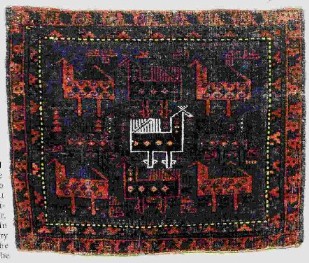
The Salon du Tapis d'Orient is a moderated discussion group in the manner of the 19th century salon devoted to oriental rugs and textiles and all aspects of their appreciation. Please include your full name and e-mail address in your posting.
by Steve Price
In a recent article in GHEREH (#20, p. 132, 1999) I called attention to an aspect of some Belouch textiles, the occurrence of design elements being hidden by juxtaposing closely related colors. Consider, for example, the balisht shown here.

The field appears to consist of two morphologically different kinds of trees or shrubs, alternating with each other.
In fact, they differ only in color. The ones that appear to be smaller actually have all the design elements of
the larger ones, and are drawn to the same scale. They appear to be smaller because their "missing" elements
are done in black, and the field color is very deep blue. Essentially the same technique can be seen in the khorjin
face shown here.

There are nine birds in the field (3 rows of 3 each), and they appear to be of four distinctly different types.
But the only significant difference among them is color. As in the balisht, design elements are rendered nearly
invisible in some of them by working them in black against a deep indigo background.
It seems reasonable to assume that the weavers were well aware that this optical effect would occur. So, we might wonder, why was it done? Several possibilities come to mind.
1. The simplest explanation: it was done for aesthetic effect. Although weaving a repetitive pattern, a much less repetitive, livelier, more interesting result is achieved by simple manipulation of the colors.
2. A more romanticized explanation: it was done as an expression of the identity of the weaver's local customs. That is, it announces and signifies its origins by using the technique of "hiding" some elements of the design in this way.
3. More romanticized yet: it embodies the notion that there are secrets known to members of the group from which it originated. Secrecy is an important element in much tribal custom, and the nature of the secrets is of much less significance than the fact that only certain people know them. Saul Barodofsky has also written about the importance in many cultures of concealing items of value from the envious gaze of others, natural and supernatural in a Salon awhile ago; this may be relevant, too.
As initial topics for discussion, I invite you to consider the following issues:
1. What is the significance of the technique of hiding some design elements by skillful manipulation of color in
certain Belouch group weavings?
2. What other methods of concealing design elements are found in the world of ethnographic textiles, and what can
we conjecture of their significance?
3. To what extent does textile art express beliefs and customs relating to secrecy?